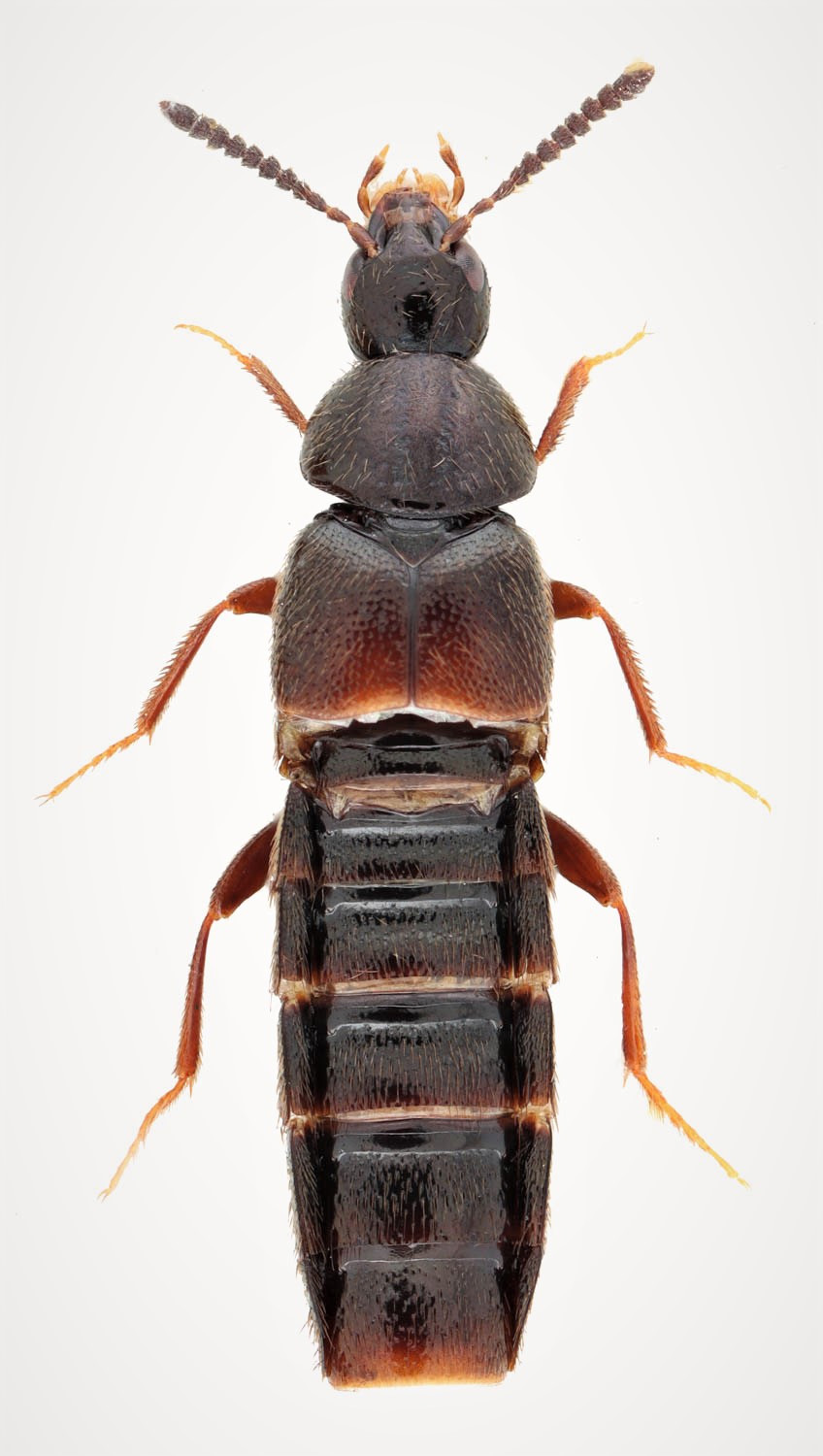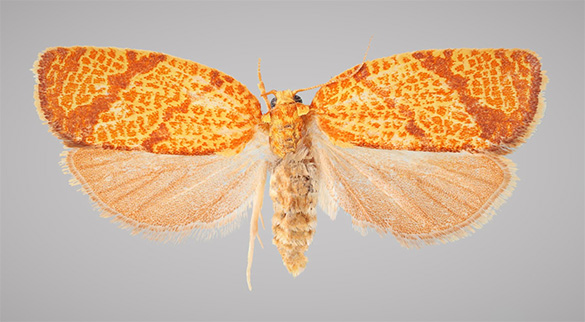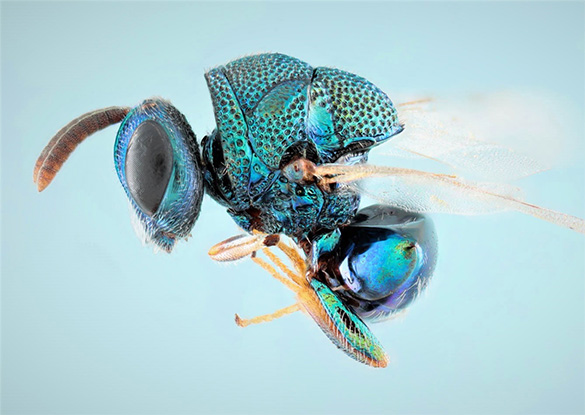The Laurentian Forestry Centre’s René Martineau Insectarium
The René Martineau Insectarium (RMI) is the leading documentation centre for forest insect diversity in Quebec and Eastern Canada. Inaugurated in 1999, the RMI's role is to support research on forest insects in the fields of biodiversity, taxonomy, and ecology of native and exotic insect pests. The RMI includes an insect collection, a database, and an extensive documentary resource on insect taxonomy. Its mission is to be an essential resource for researchers and students working on forest insect biodiversity.
On this page:
- What's in the insectarium?
- Collections
- Access to the René-Martineau Insectarium
- Contacts and location
- Specimen donations
- Guidelines for accepting new specimens
- René Martineau
What's in the insectarium?

250,000 specimens, mainly forest insects, including:
- 1,800+ type specimens, including over 35 holotypes
- 2,500+ Coleoptera species
- 1,158 Lepidoptera species
- 1,584 Hymenoptera species (1,143 Ichneumon species)
- 146 Homoptera species
- 189 Heteroptera species
- 108 Collembola species
- A small number of Blattodea, Orthoptera, Mantodea, Dermaptera and Odonata species
The RMI also holds an important collection of Aleocharinae (Coleoptera: Staphylinidae) specimens from the taxonomic projects of Dr. Jan Klimaszewski, the collection's previous curator until 2021. It contains many uncommon or new species of aleocharinae, making it the most important reference collection in Canada for this group. Finally, the RMI also holds a bank of high-resolution images of uncommon and often dissected forest insects. This collection is growing rapidly and can be consulted by visitors to the RMI.
The RMI also has a unique collection of 40,000 slides representing over 900 species of forest phytophagous insects at different stages of development (stored at Archives Canada), assembled by the Forest Insect and Disease Survey program staff and now integrated into a database. Of these images, 13,000 have been carefully selected and digitized.
Collections

The RMI has a large research collection, with the majority of specimens coming from Eastern Canada. The groups best represented are those studied by these specialists. In addition to being the repository for insects collected by Laurentian Forestry Centre entomologists, the RMI accepts donations if they enrich the collection in terms of specimen diversity or collection data.
Main collection
The main collection includes specimens collected over the years as part of the Forest Insect and Disease Survey program (FIDS, between 1952 and 1984), by a research program on the ecology and diversity of forest insects (since 1992), as well as numerous other projects carried out by research teams at the Laurentian Forestry Centre. It also contains specimens bequeathed to the RMI by other institutions, or by the public.
Specimens in the main collection are in the public domain and can therefore be consulted by any individual or group for research purposes on request. The specimens can be examined on-site with microscopes and binocular loupes. Specimens may also be loaned.
Type specimen collection
Type specimens are the original specimens used to describe and publish new species for science. They are considered reference specimens for defining the limits of a species and are invaluable. Most type specimens come from the work of the taxonomists who have worked at the RMI, but some may have been donated by other collections.
The collection of type specimens is kept within the RMI, in a cabinet specially designed to ensure maximum protection. These specimens can be borrowed for research projects, with the authorization of the manager and curators. However, high-resolution photos are preferred.
Access to the René-Martineau Insectarium
Visits
Visits to the RMI are encouraged, but group visits require permission from the collection manager. The RMI is open to visitors Monday to Friday, 8 a.m. to 4:30 p.m.
Loans
On-site visits to the permanent collection are preferred. However, some components of the main collection may be loaned to scientific institutions or researchers affiliated with them with the approval of the curator and in accordance with certain specifications.
The maximum loan period for ordinary specimens in the main collection is usually one year. The maximum loan period for type specimens in the main collection is six months.
For any given species in the main collection, no more than two thirds of the total number of specimens may be loaned out.
The customary precautions must be taken to minimize potential damage to the specimens. All specimens must always be sent and returned by courier service or by registered mail. If specimens become damaged during transport, the curator must be informed promptly, in writing.
All loans of insects must be approved by the curator. All loans exceeding the maximum loan period must also be approved by the Laurentian Forestry Centre research director. The terms of the loan will be specified on the RMI loan form.
Research collections from ongoing or incomplete projects are under the care of an individual researcher. These collections are not yet part of the permanent collection, and therefore cannot be loaned. Once the research project has been completed, the specimens will become part of the permanent collection and will be available for loan.
Equipment
To protect the RMI's scientific equipment, new users are required to receive training from the curators or collection manager. Anyone wanting to use this equipment for an extended period must reserve time slots through the manager.
Contacts and location
Collection manager
Nicolas Bédard
Insect identification biologist
nicolas.bedard@nrcan-rncan.gc.ca
(418) 563-2691
Curator
Assistant curator
Address
Natural Resources Canada
Canadian Forest Service
Laurentian Forestry Centre
1055 du P.E.P.S.
P.O. Box 10380, Stn. Sainte-Foy
Québec (Quebec) G1V 4C7
Canada

Specimen donations
Donations of insect specimens play an important role in enriching insect collections held by natural history museums and similar institutions, and are greatly appreciated.
Private collections are often the culmination of a lifetime's interest in one or more particular groups of insects. Over the years, they have amassed a large number of taxa, including species that are rare, non-native or from unique or now extinct environments. These collections have tremendous scientific and historical value, since they provide crucial information on the geographic range and range expansions of given species (e.g., a non-indigenous species expanding its range, or an indigenous species undergoing range expansion because of global warming).
Donated specimens constitute highly valuable reference tools.
Procedure
Prospective donors are required to contact the RMI collection manager. The latter will want to see the list of insect species and specimens to be donated, as well as any information on the rarity of the species or specimens, in order to assess how they would complement the existing RMI collection. The manager examines the list and gives it to the curator for validation. The curator forwards the list to the Laurentian Forestry Centre's research director, who decides whether to acquire the collection, based on a set of acceptance guidelines.
Once the research director approves the gift in writing, the collection manager initiates the process of acquiring the specimens. The value of a donation is calculated using the Canadian National Collection of Insects, Arachnids and Nematodes evaluation grid.
Guidelines for accepting new specimens
The RMI is a specialized research facility focusing on the study of terrestrial forest insects, in particular Coleoptera, Lepidoptera and parasitoids (Diptera and Hymenoptera). Due to the RMI's limited storage space and priorities, its collections differ slightly from those of natural history museums. Insect species studied include mainly forest pests, introduced species and insects associated with forest environments.
Priority will be given to the acquisition of species from Quebec and eastern Canada, as the majority of the Laurentian Forestry Centre's research focuses on these regions. Consequently, the RMI strives to maintain a comprehensive collection of forest insects from these regions.
It is important to note that the RMI does not limit itself to species from Quebec and eastern Canada, but also seeks to acquire specimens from other geographical regions if deemed relevant to research projects carried out at the Laurentian Forestry Centre. However, due to research priorities and limited storage space, the acquisition of species from other regions will be less frequent.
The following criteria will be taken into account to guide the selection of new specimens for donation to the RMI. Specimens with the following characteristics will be considered of particular interest to the collection:
Taxonomic value
Species that are not currently represented in the RMI collection or that are represented by only a few specimens receive a high priority rating. Specimens that represent type series are given priority, and specimens identified to the species level take precedence over those identified only to the genus level or a higher level. Similarly, specimens identified by an expert take precedence over those identified by a non-expert.
Taxonomic identity
Since members of the order Coleoptera and Lepidoptera are currently the focus of many researchers at the Laurentian Forestry Centre, these orders take precedence over other groups of insects.
Provenance
Priority is given to specimens: a) from Quebec and eastern Canada, b) captured in localities that are not represented in the RMI collection, c) belonging to species for which only one or a few specimens exist in the RMI collection at present, or d) captured in a threatened habitat or one that no longer exists. Exotic forest pests that are likely to be introduced into Quebec and eastern Canada are also given high priority.
Overall value of collections
The overall value of any collection offered as a gift and the identity of the collection owner are also considered. Some collections are highly valuable because they represent a lifetime of work and feature rare species or species from habitats that are rare or no longer exist. These characteristics will enhance both the historical value and usefulness of the RMI collection.
Number of specimens per species
The RMI generally accepts a large series of the same species, but will generally limit the number of specimens from the same locality to 15. However, exceptions could be made if the specimens a) belong to a rare species or come from a rare, threatened or no longer existing habitat; b) represent a new pest species or one that has caused considerable damage in the past; or c) are type specimens (original specimens on which the description of the nominal species is based). Consideration is also given to the fact that a larger number of specimens provide data on intraspecific variability, increases the chance of obtaining specimens of both sexes and helps to buffer possible losses during specimen handling (e.g., examination and transport).
René Martineau was born in 1915 and devoted his life to scientific research in forest entomology. After graduating from Université Laval in forest engineering and surveying in 1939, he obtained a Master’s degree in forest entomology from the University of Illinois (1941) and Yale University (1944). He worked as a forest entomologist with the Quebec Department of Lands and Forests for 13 years, and later joined the Canadian Forest Service as a research scientist. During his career, he drew on his vast experience and knowledge to write many publications, including Insects Harmful to Forest Trees (1984), which is still a key reference book in forest entomology.
Page details
- Date modified: